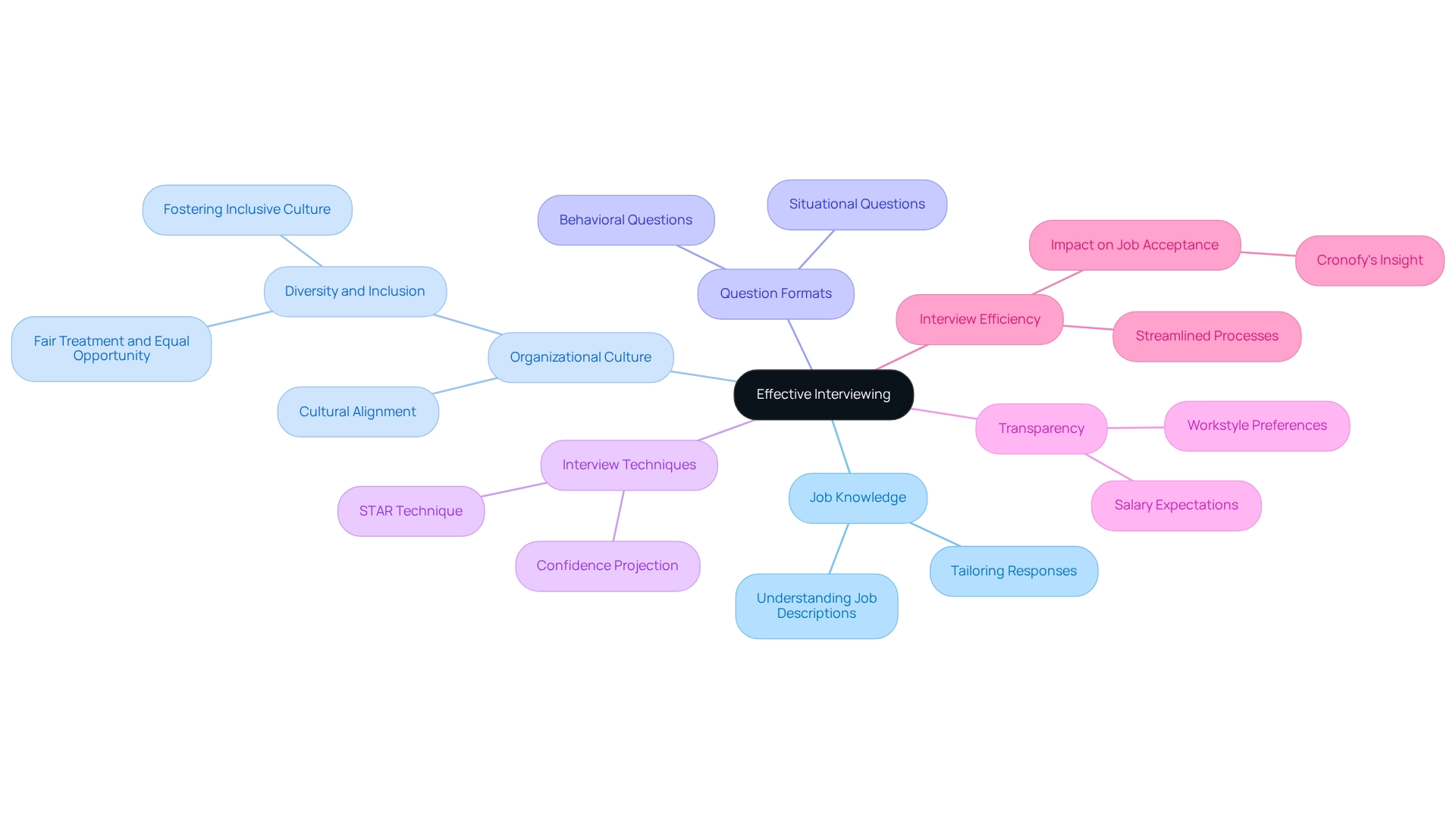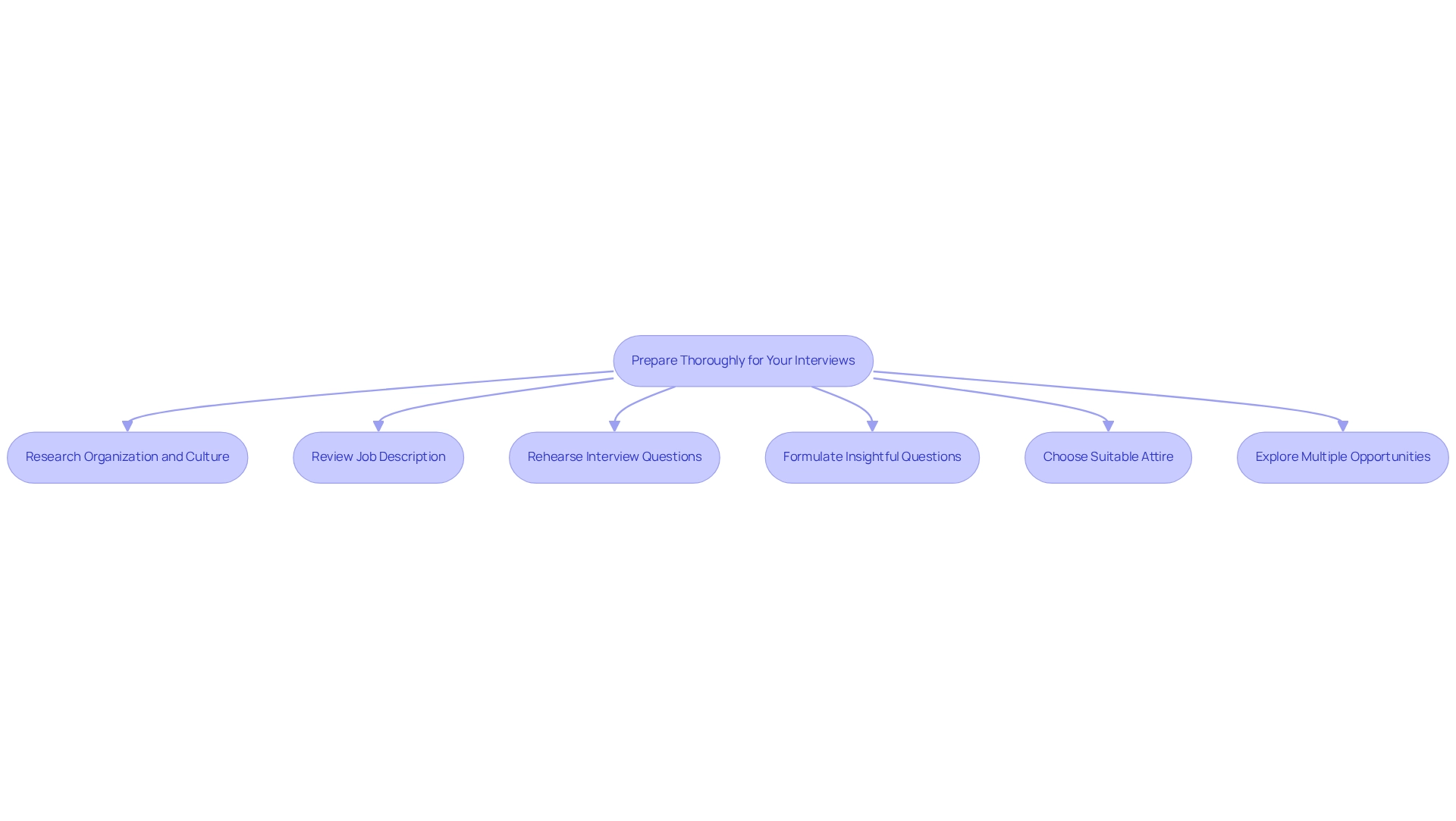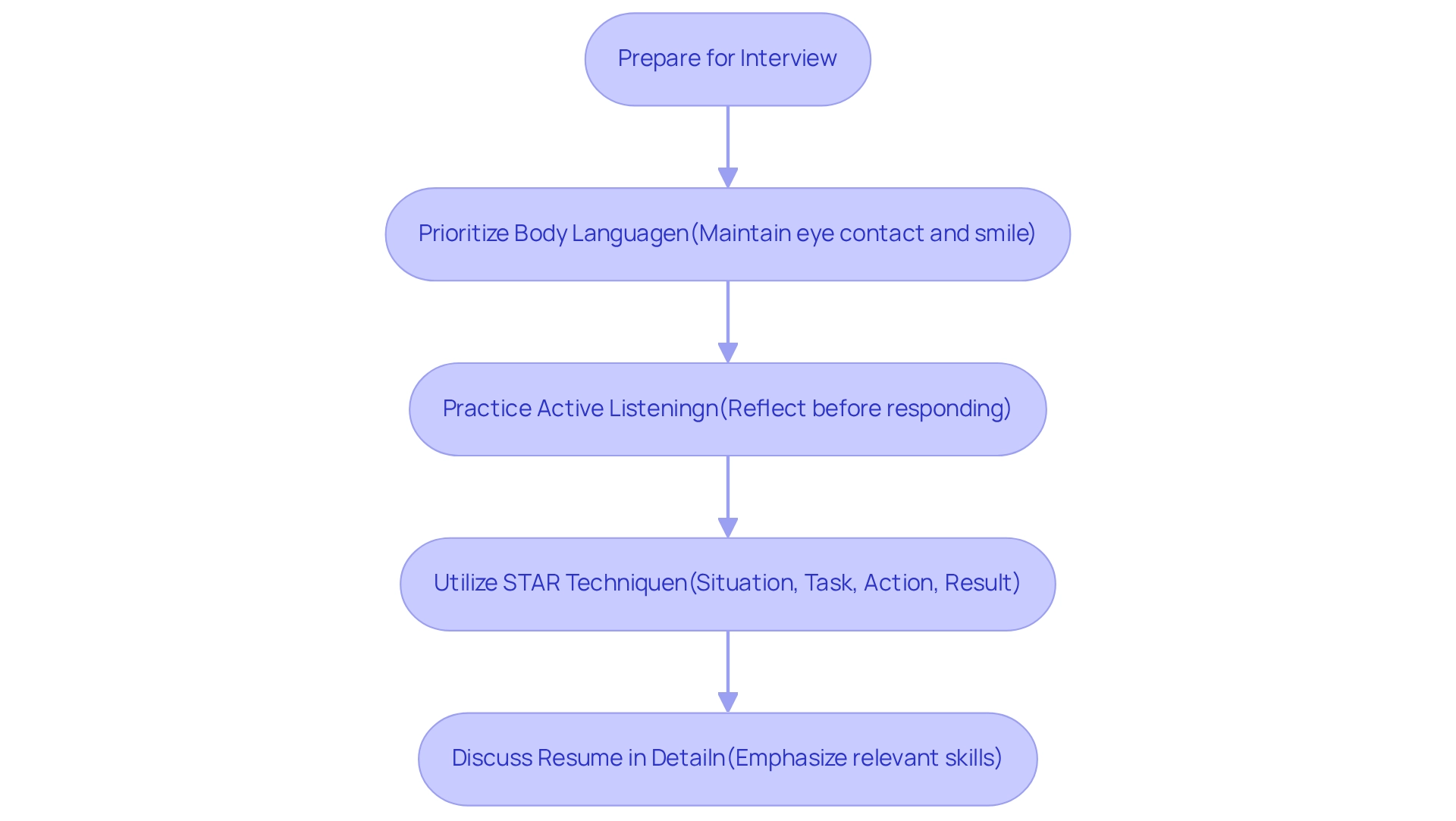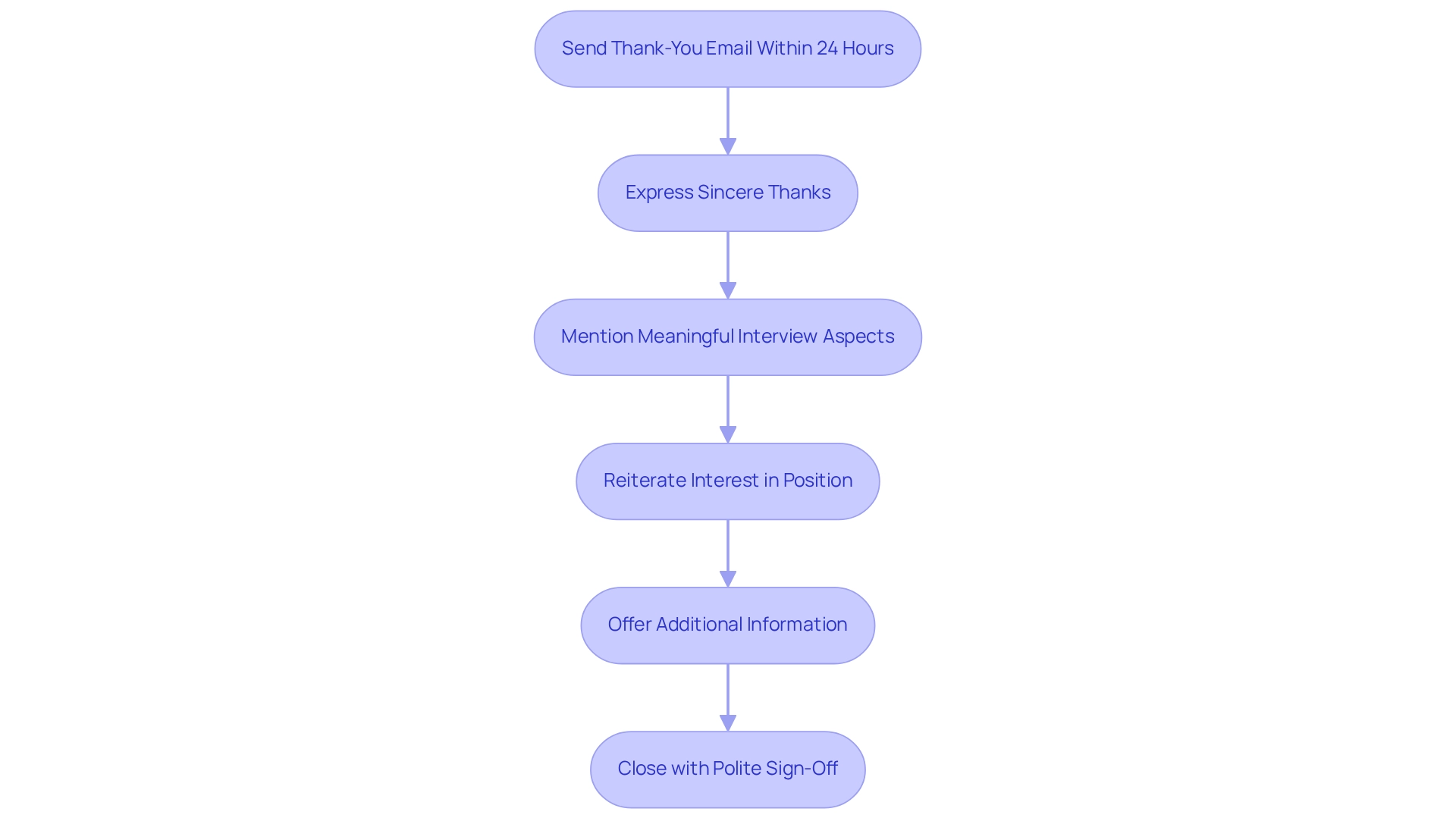Overview
To excel in interviews, candidates must prioritize:
- Comprehensive preparation
- Articulate communication
- Strategic follow-up
Mastering the STAR technique for structured responses and exhibiting confidence through body language are essential components. This approach underscores the significance of:
- Grasping organizational culture
- Rehearsing common interview questions
- Engaging in timely follow-up communications
Collectively, these strategies amplify the candidate’s attractiveness to prospective employers.
Key Highlights:
- Effective interviewing relies on understanding the job outline, organizational culture, and common questioning formats.
- Candidates should prepare for behavioral and situational questions using the STAR technique to present experiences effectively.
- Confidence impacts hiring decisions, with 40% of interviewers citing it as a significant factor.
- High-quality candidates often secure new positions within ten days, highlighting the competitive job market.
- Diversity in hiring is increasingly prioritized, with a focus on creating inclusive cultures that value fair treatment.
- Candidates should be transparent about workstyle preferences and salary expectations to foster trust with hiring managers.
- Preparation involves researching the organization’s mission and recent developments to align personal values with the company.
- Candidates should practice typical interview questions and dress appropriately to reflect the organization’s culture.
- Nonverbal communication, such as body language, significantly influences interview outcomes; 55% of communication is nonverbal.
- Sending a thank-you email within 24 hours post-interview reinforces professionalism and enthusiasm for the role.
- Follow-up communications are crucial; timing is more important than the number of follow-ups to maintain engagement.
Introduction
In a landscape where securing a job is more competitive than ever, mastering the art of interviewing has become an essential skill for candidates. The interview process can often feel overwhelming, from understanding the nuances of company culture to effectively communicating personal experiences. Yet, with the right strategies in place, candidates can navigate this challenging terrain with confidence.
This article delves into the key components of effective interviewing, offering insights on:
- Preparation
- Execution
- Follow-up techniques
These techniques not only highlight individual strengths but also align with organizational values. By embracing these practices, candidates can significantly enhance their chances of making a lasting impression and ultimately landing their desired roles.
Understand the Basics of Effective Interviewing
Successful questioning relies on various crucial elements: a comprehensive grasp of the job outline, awareness of the organizational culture, and knowledge of typical questioning formats. Candidates must understand how to improve their interviewing skills by preparing for various question types, particularly behavioral and situational inquiries, ensuring their responses resonate with the company’s core values. Mastering the STAR (Situation, Task, Action, Result) technique is especially advantageous for honing interview skills, as it enables individuals to showcase their skills and experiences in a structured and impactful manner.
Statistics indicate that 40% of interviewers believe a person’s overall confidence significantly affects hiring decisions, underscoring the importance for applicants to project assurance during interviews. Furthermore, high-quality candidates typically secure new positions within just ten days, reflecting the competitive nature of the job market, often referred to as the ‘war for talent.’ Comprehending job descriptions is essential for applicants who aim to enhance their interviewing capabilities; it helps them tailor their responses and align their qualifications with the specific requirements of the position.
Companies are increasingly recognizing the importance of diversity in hiring, evolving from merely filling positions to fostering an inclusive culture that values fair treatment and equal opportunity. This transformation is evident in effective selection strategies that emphasize both skill evaluation and cultural alignment, especially in remote work settings where successful assessment methods must adapt to new formats. Moreover, individuals are urged to embrace transparency throughout the selection process.
Being forthcoming about workstyle preferences, salary expectations, and unique personal circumstances fosters trust and enables hiring managers to better assess suitability for the role. Hiring managers expect applicants to be clear about their preferred work arrangements—whether hybrid, on-site, or remote—and to provide detailed explanations of why these arrangements are significant. As noted by Cronofy, ‘72% of applicants say meeting efficiency affects job acceptance,’ highlighting the necessity of streamlined processes in attracting top talent.
By implementing these strategies, including insights from the case study on diversity in hiring and effective methods for interviewing remote candidates, recruiters can discover ways to enhance their interviewing processes, ensuring they identify individuals who not only meet technical qualifications but also align with the organizational ethos.
Prepare Thoroughly for Your Interviews
Successful preparation for discussions begins with an in-depth exploration of the organization and its culture. Candidates must familiarize themselves with the organization’s mission, values, and any recent developments that may impact its operations. This foundational knowledge not only aids in aligning personal values with the company but also equips individuals to engage meaningfully during the interview.
A detailed review of the job description is essential, as it enables applicants to identify the key skills and experiences they should emphasize. Rehearsing typical questioning scenarios with a companion or guide can significantly enhance confidence and improve presentation, ensuring individuals showcase themselves proficiently. Additionally, formulating insightful inquiries for the interviewer is crucial, as this illustrates sincere interest and involvement, setting a candidate apart from others.
Research indicates that 72% of applicants believe that the efficiency of discussions affects their job acceptance, underscoring how being well-prepared contributes to a more effective selection process. Moreover, 80% of job applicants have declined job offers due to negative interview experiences, highlighting the significance of a favorable applicant experience.
Choosing suitable attire that reflects the organization’s culture is another vital aspect of creating a positive first impression. Applicants should strive to dress in a manner that aligns with the organization’s atmosphere, further demonstrating their comprehension of the firm.
In today’s competitive job market, where 47% of individuals are rejected due to a lack of clarity about the job role and organization, thorough preparation is not merely beneficial—it is essential for success. Understanding company culture, particularly in organizations that emphasize diversity, can also enhance an applicant’s compatibility and attractiveness. Furthermore, candidates should remember that the initial job proposal may not always be the most suitable.
Exploring multiple opportunities can uncover roles that better align with long-term aspirations and career goals. Candidates must also be cautious of committing too quickly to a job offer, as this can lead to regret. With projections indicating a global talent shortage, candidates must differentiate themselves through meticulous preparation to stand out in the hiring process.
Execute the Interview with Confidence and Clarity
Candidates must prioritize effective body language during discussions, which encompasses maintaining eye contact, smiling, and sitting up straight to convey confidence. Research underscores that nonverbal cues significantly shape perceptions during interviews; for instance, a study titled “Impact of Nonverbal Facial Behaviors in Job Interviews” reveals that smiling and eye contact are among the most valued behaviors by employers. Notably, statistics indicate that 55% of communication is nonverbal, highlighting the critical role of body language in establishing a positive impression.
Equally essential is active listening; applicants should take a moment to reflect on the interviewer’s questions before responding, ensuring their answers are both clear and relevant. Utilizing the STAR technique—Situation, Task, Action, Result—can aid individuals in structuring their responses effectively. For instance, an applicant might detail a challenging project (Situation), their specific role in it (Task), the steps they undertook to address it (Action), and the successful outcome (Result), thus making their experiences more compelling.
Moreover, applicants should be prepared to discuss their resumes in detail, emphasizing pertinent skills and experiences that align with the job requirements. Expressing genuine enthusiasm for the role and the company can leave a lasting positive impression. It is vital to recognize that body language is culturally bound, as misinterpretations can arise without an awareness of cultural nuances.
For example, while direct eye contact is esteemed in many Western cultures, it may be perceived differently elsewhere. By mastering these skills, candidates can enhance their interviewing capabilities, improve performance in assessments, and significantly increase their likelihood of success.
Follow Up Effectively After the Interview
Candidates should send a thank-you email within 24 hours of the meeting to express appreciation for the opportunity. This email should not only convey appreciation but also briefly reiterate interest in the position and highlight specific points discussed during the interview that resonated with them. Addressing any questions or concerns that arose can further demonstrate engagement and thoughtfulness.
Research indicates that follow-up communications are crucial in the hiring process, with multiple follow-ups often necessary to maintain engagement without overwhelming the interviewer. A well-timed follow-up email can significantly influence hiring decisions, as it reinforces the applicant’s professionalism and enthusiasm for the role. In fact, a case study titled “Frequency of Follow-ups” suggests that the timing of follow-up emails is more crucial than the number sent; allowing 2-3 days for prospects to respond is recommended to enhance engagement without appearing pushy.
To craft an effective thank-you email, candidates should consider the following:
- Start with a warm greeting and express sincere thanks.
- Mention specific aspects of the interview that were particularly meaningful.
- Reiterate interest in the position and the company.
- Offer to provide any additional information if needed.
- Close with a polite sign-off.
For example, a thank-you email that references a shared discussion point can leave a lasting impression and may even lead to job offers. As Austin Belcak states, “Remember, your thank you note is a huge opportunity for you to stand out, continue building a relationship with your interviewer, and cement that positive association in their mind.” Candidates who send thoughtful thank-you notes often stand out in the hiring process, as highlighted by industry experts.
Ultimately, patience and respect for the hiring timeline are essential. Candidates should remain open to further communication, as this approach not only reflects professionalism but also enhances their chances of success in a competitive job market.
Conclusion
Mastering the art of interviewing is a multifaceted process that demands thorough preparation, confident execution, and thoughtful follow-up. Understanding the nuances of effective interviewing can significantly enhance a candidate’s chances of making a lasting impression. Preparation begins with an in-depth exploration of the company culture and job description, enabling candidates to align their responses with the organization’s values. Practicing common interview questions and formulating insightful inquiries for interviewers not only demonstrates genuine interest but also distinguishes candidates in a competitive landscape.
During the interview, projecting confidence through effective body language and active listening is paramount. Techniques like STAR empower candidates to articulate their experiences clearly and compellingly. Furthermore, expressing enthusiasm for the role and the organization can leave a positive impact on interviewers, shaping their perceptions and decisions.
The follow-up process is equally crucial in reinforcing a candidate’s professionalism and interest in the position. A timely thank-you email that reflects on specific points discussed during the interview can strengthen the connection with the interviewer, ensuring that the candidate remains top of mind. In a competitive job market, where every detail counts, being proactive and thoughtful in communication can indeed make all the difference.
In summary, effective interviewing transcends merely answering questions; it encompasses showcasing one’s fit for the role and the organization. By embracing preparation, confident execution, and strategic follow-up, candidates can navigate the challenges of the interview process with poise, thereby increasing their chances of securing their desired roles. The journey may be demanding, yet with these strategies in hand, candidates can approach interviews as invaluable opportunities to shine.
Frequently Asked Questions
What are the key elements for successful questioning during interviews?
Successful questioning relies on a comprehensive understanding of the job outline, awareness of the organizational culture, and knowledge of typical questioning formats.
How can candidates improve their interviewing skills?
Candidates can improve their interviewing skills by preparing for various question types, particularly behavioral and situational inquiries, and by ensuring their responses resonate with the company’s core values.
What is the STAR technique, and how does it help in interviews?
The STAR technique stands for Situation, Task, Action, Result. It helps individuals showcase their skills and experiences in a structured and impactful manner during interviews.
Why is confidence important during interviews?
Statistics indicate that 40% of interviewers believe a person’s overall confidence significantly affects hiring decisions, making it crucial for applicants to project assurance during interviews.
How quickly do high-quality candidates typically secure new positions?
High-quality candidates typically secure new positions within just ten days, reflecting the competitive nature of the job market.
Why is understanding job descriptions essential for applicants?
Comprehending job descriptions helps applicants enhance their interviewing capabilities by allowing them to tailor their responses and align their qualifications with the specific requirements of the position.
How are companies evolving in their approach to hiring?
Companies are increasingly focusing on diversity in hiring and fostering an inclusive culture that values fair treatment and equal opportunity, moving beyond merely filling positions.
What should candidates be transparent about during the selection process?
Candidates should be forthcoming about their workstyle preferences, salary expectations, and unique personal circumstances to foster trust and help hiring managers assess suitability for the role.
What do hiring managers expect regarding work arrangements?
Hiring managers expect applicants to be clear about their preferred work arrangements—whether hybrid, on-site, or remote—and to explain why these arrangements are significant.
How does meeting efficiency impact job acceptance?
According to Cronofy, 72% of applicants say meeting efficiency affects job acceptance, highlighting the necessity of streamlined processes in attracting top talent.






